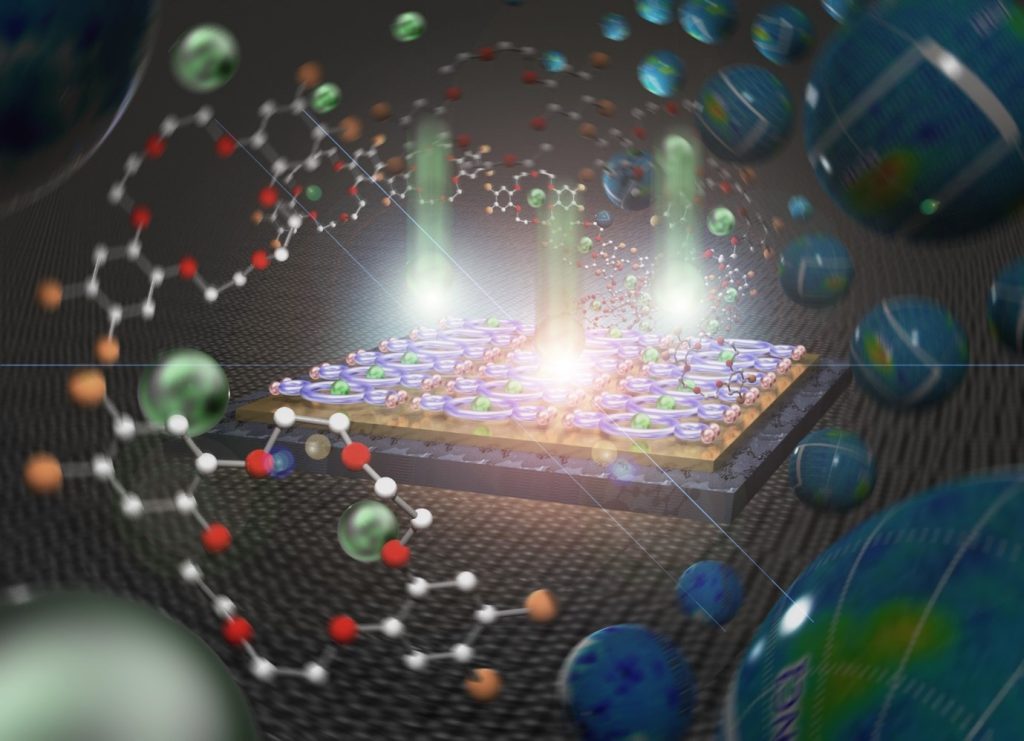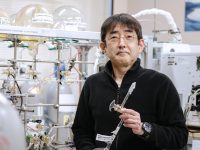Researchers demonstrate the growth of cobalt nanoclusters on two-dimensional copper surfaces using an array of ring-shaped crown ether molecules
Nanoclusters (NCs) of transition metals like cobalt or nickel have widespread applications in drug delivery and water purification, with smaller NCs exhibiting improved functionalities. Downsizing NCs is, however, usually challenging. Now, scientists from Chiba University in Japan have demonstrated functional NC formation with atomic-scale precision. They successfully grew cobalt NCs on flat copper surfaces using molecular arrays as traps. This breakthrough paves the way for advancements like single-atom catalysis and spintronics miniaturization.

Image title: Room Temperature Precision Formation of Cobalt Nanoclusters.
Image caption: Researchers demonstrate the successful formation of functional nanoclusters using cobalt atom deposition on two-dimensional arrays of crown ether ring molecules.
Image credit: Masaki Horie from National Tsing Hua University
Image license: Original content
Nanoclusters (NCs) are crystalline materials that typically exist on the nanometer (10-9 m) scale. They are composed of atoms or molecules in combination with metals like cobalt, nickel, iron, and platinum, and have found several interesting applications across diverse fields, including drug delivery, catalysis, and water purification. A reduction in the size of NCs can unlock additional potential, allowing for processes such as single-atom catalysis. In this context, the coordination of organic molecules with individual transition-metal atoms shows promise for further advancement in this field.
An innovative approach to further reduce the size of NCs involves introducing metal atoms into self-assembled monolayer films on flat surfaces. However, it is crucial to exercise caution in ensuring that the arrangement of metal atoms on these surfaces does not disrupt the ordered nature of these monolayer films. Now, in a recent study featured in the Journal of Materials Chemistry C, Dr. Toyo Kazu Yamada from the Graduate School of Engineering at Chiba University, along with Masaki Horie from the Department of Chemical Engineering at National Tsing Hua University, Satoshi Kera from the Institute for Molecular Science, and Peter Krüger also from the Graduate School of Engineering at Chiba University, have showcased the surface growth of cobalt atoms on molecular ring arrays at room temperature.
Talking to us about this advancement. Dr. Yamada says, “This advanced method of functional nanocluster formation with atomic-scale precision can be utilized in the development of highly efficient catalysts or in quantum computing.”
In the study, the team used ring-shaped molecular structures called “crown ethers,” which contain benzene and bromine rings. These structures were used to trap and grow cobalt NCs on flat copper surfaces. The resulting cobalt NCs were of two sizes, 1.5 nm and 3.6 nm. To understand their properties and structure further, various techniques were employed, including low-temperature scanning tunneling microscopy and spectroscopy (STM and STS), angle-resolved photoelectron spectroscopy (ARPES) with low energy electron diffraction (LEED), and density functional theory (DFT) calculations.
The analysis revealed the formation of stable surface sites to which the cobalt atoms could attach. In addition, the formation of these stable surface sites was found to be influenced by the electronic hybridization (mixing) between the crown ethers and cobalt. Once the cobalt atom was trapped, it acted like a nucleation center, attracting other cobalt atoms to form an NC. Additionally, unlike the usual behavior of crown ether molecules in solution, these molecules did not trap the metal atom at the center of the crown ring. Instead, the metal atom was at the edge, because of the presence of bromine atoms at that location. Discussing the long-term potential of these findings, Dr. Yamada says, “The use of this approach in applications such as single-atom catalysis, miniaturization of spintronics media, and quantum computing will contribute to the development of an information-based society in a way that reduces carbon dioxide (CO2) production.”
In summary, the team successfully demonstrated the growth of cobalt NCs by exploiting the trapping potential of two-dimensional crown ether molecules on a copper surface. The chemical behavior of the crown ether molecules deviated from typical interactions observed in solution, by trapping cobalt atoms at the edge, and not the center. Importantly, the method demonstrated effective and large-scale production of NCs with well-defined size and morphology at room temperature.
Funding:
This work was supported by JSPS KAKENHI grant numbers 17K19023 and 23H02033, the Murata Science Foundation, the Shorai Foundation for Science and Technology, TEPCO Memorial Foundation, Casio Science Promotion Foundation, and Toshiaki Ogasawara Memorial Foundation.
Reference:
Title of original paper: On-surface growth of transition-metal cobalt nanoclusters using a 2D crown-ether array
Authors: Toyo Kazu Yamada1,2, Ryohei Nemoto1, Fumi Nishino1, Takuya Hosokai3, Chi-Hsien Wang4, Masaki Horie4, Yuri Hasegawa5, Satoshi Kerae5, and Peter Krüger1,2
Affiliations:
- Department of Materials Science, Chiba University
- Molecular Chirality Research Centre, Chiba University
- National Metrology Institute of Japan, National Institute of Advanced Industrial Science and Technology
- Department of Chemical Engineering, National Tsing Hua University 5Institute for Molecular Science
Journal: Journal of Materials Chemistry C
DOI: 10.1039/d3tc03339b
Contact: Toyo Kazu Yamada
Graduate School of Engineering, Department of Materials Science, Chiba University
Email: toyoyamada@faculty.chiba-u.jp
Public Relations Office, Chiba University
Address: 1-33 Yayoi, Inage, Chiba 263-8522 JAPAN
Email: koho-press@chiba-u.jp
Tel: +81-43-290-2018
Recommend
-

Towards a self-sustainable natural environment: The science of restoration ecology, where researchers engage in conversation with the earth
2023.02.02
-

“Journey of the Brave,” a new cognitive behavioral therapy program: a solution for children’s anxiety
2023.04.19
-

Harnessing CO2 with a Photocatalyst for Fuel and Plastic Feedstocks: Advancing a Sustainable Society with Chemistry
2023.06.22


